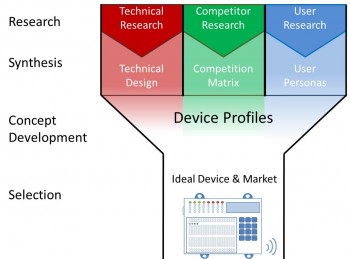Engineering Education Tools for The MathWorks
Background
Virtually every university use MATLAB or Simulink as a teaching tool. Students use the arsenal of advanced mathematics commands and the simple scripting interface of MATLAB to develop simulations and perform analysis. However, as engineering curricula look to integrate real-world experiments, students have to switch away from MATLAB and Simulink and move into complete different software and hardware systems. Our team is developing a product for The MathWorks which will allow students to seamlessly apply their knowledge of MATLAB and Simulink to model and control real world systems.
Process
While The MathWorks realized that they wanted to develop a hardware based teaching tool, they had not identified the specific functionality or target market. In order to identify the market to enter and the ideal product to meet the needs of that market, we developed a multi-faceted design process, illustrated below. During this process, we took into account technical possibilities, what competitors were doing, and the needs to users within the higher education industry. We synthesized the raw data into a variety of separate representations including user personas.
Combining the distinct viewpoints together allowed us to develop a set of Device Profiles. These Device Profiles, presented with marketing brochures, represented potential products which had different sets of features and purposes. They ranged in target audience, target use, price point and capabilities to show different potential directions for the product. Based on feedback from The MathWorks and users we revised our design and developed a single profile with a single target audience.
At this point, we are developing a technical prototype which is scheduled to be completed in May 2010 for initial testing in classrooms in Fall 2010.
Results
Based on our research, we identified a target market of entry level engineering classes. These are classes where professors are teaching higher level concepts and are less focused on technical details. Because of this, professors and students are looking for an easy to use, versatile solution. By analyzing the competitors on the market, we realized that there was not a highly-versatile, low cost, product on the market. Because we are riding Moore’s Law, we are able to design a more versatile system for a lower price point. By leveraging the power of MATLAB and Simulink, we are able to develop a product which is also easy to use. Taking these traits as goals, we designed the specific functionality of the device.

